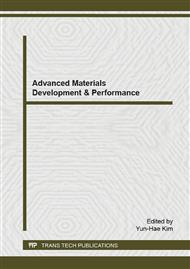p.125
p.130
p.136
p.142
p.148
p.152
p.158
p.163
p.169
Improvement of Corrosion Resistance of Carbon Steel by AIH-FPP with Cr/Ni Hybridized Particles
Abstract:
In order to improve corrosion resistance of carbon steel by AIH-FPP treatment using Cr/Ni hybridized particles, the specimens was peened in an argon atmosphere , at 1200°C , for 30 s, varying post heating time from 0 s to 300 s. Cr and Ni particles were mixed by means of a planetary ball mill to obtain hybridized particles, and it was used as shot particles. Results showed that changing the post heating time strongly affects the characteristics of modified layer at the specimen surface. Results of EDX analysis showed that the Cr and Ni diffused layer was formed at the post heating time of 300 s. Corrosion tests were performed using a three-electrode electrochemical cell connected to a computer driven potentiostat. The specimens with Cr and Ni diffused layers showed a wide passive region and almost the same pitting corrosion resistance of Stainless Steel (X30Cr13). This is because of the existence of Cr passive films on treated surfaces.
Info:
Periodical:
Pages:
148-151
Citation:
Online since:
June 2015
Price:
Сopyright:
© 2015 Trans Tech Publications Ltd. All Rights Reserved
Share:
Citation:


